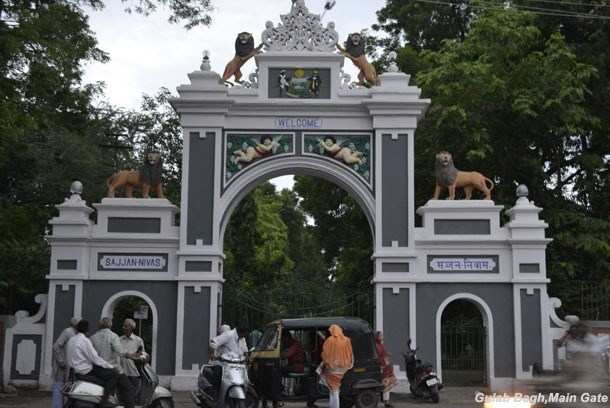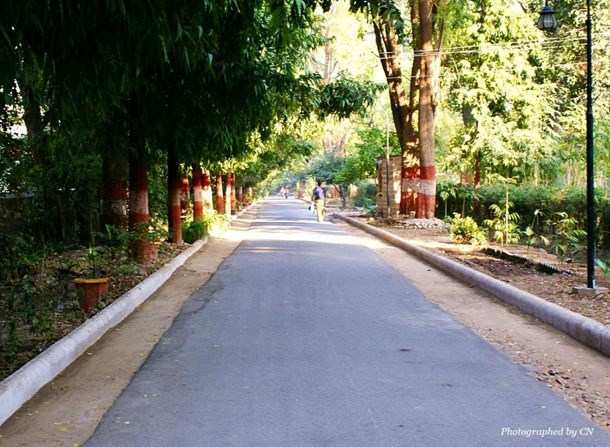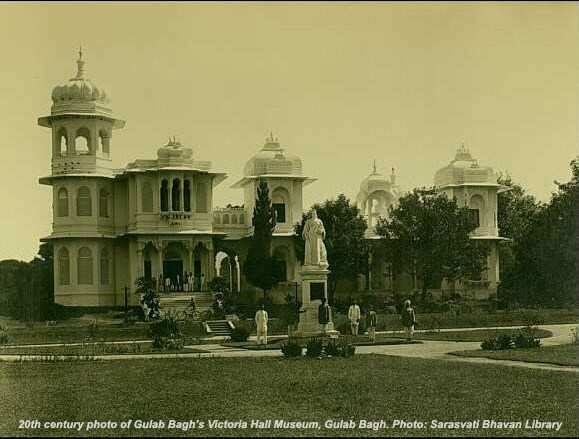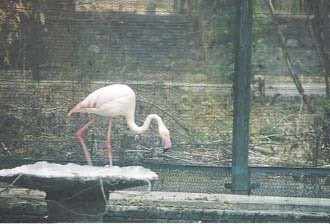Gulab Bagh: Past, Present and…No Future?
The Udaipur Zoo (Sajjan Niwas Garden), popularly known as Gulab Bagh, is an inseparable part of the life and memories of any Udaipurite. It is not only the heritage of this city, but of the entire nation. Started in the year 1878, it is one of the four oldest zoos of India. It was set up by Maharana Sajjan Singh of Mewar.
 Majorly contributed By Raza H. Tehsin
Majorly contributed By Raza H. Tehsin
The Udaipur Zoo (Sajjan Niwas Garden), popularly known as Gulab Bagh, is an inseparable part of the life and memories of any Udaipurite. It is not only the heritage of this city, but of the entire nation. Started in the year 1878, it is one of the four oldest zoos of India. It was set up by Maharana Sajjan Singh of Mewar.
The Maharana allotted 66.5 acres of land for the garden and zoo and sanctioned 15,625 rupees, 15 annas and 3 paisa. He wanted to stock the garden with plants that had some medicinal values and called Mr. T. H. Story, the renowned specialist in gardens from Madras and employed him for a salary of Rs. 300/- per month. Mr. Story worked for this complex from 1882 to 1920. Many varieties of trees, shrubs and herbs were imported from other places in India and British colonies.
A lotus pond was constructed and the cost of seeds of lotus for that pond was 61 annas and 3 paisa. Amongst the most prominent trees of the garden were many varieties of mangoes, guava, grapes, lemon, bor, mulbury, rayan, pomegranate, bananas, sapota, tamarind, bullock’s heart (ramphal), lichi, arjun trees, wood apple, karonda, campher, citron, jamun, pummelo, meetha neem, kargi lime, ficus species, anola, jack fruit, dhanverjia, grandi flora, jasmin, dawood etc.
In the year 1882, all the trees had their name-plates denoting Hindi, English, and systematic botanical names, which are not the same now. Bougainvillea was planted for the first time in the year 1886 and within 6 years it attained a height of 77 feet!
There was a small pond that was destroyed when the water works complex was constructed on it a few years back. In this pond an aquatic plant, probably Victoria retelia, was initially planted. The radius of the flower of that plant was 12 inches and the buoyancy of the leaves was so much that it could withstand a child on a chair kept on it! Photographic illustrations of this can be seen in old books.
This garden was known as Gulab Bagh because near Navlakha Mahal, which is situated in the garden, there was a big ranch (badi) where roses were in abundance. This garden was also called Bada Bagh but the official name of it is Sajjan Niwas Garden.
On August 1882, Maharishi Swami Dayanand inaugurated Navlakha Mahal. The Maharaja was elated by the swami’s stay. The boundary of the garden was constructed in 1885-86 and the garden was divided into 45 parts according to different flowers, trees, zoo complex and so on.
Maharana Sajjan Singh placed the foundation stone of the Victoria museum in the garden on 2nd November 1890. It was inaugurated by Lord Lansdown. Mr. Gauri Shankar Ojha was the first curator of this museum appointed in the year 1890. This museum had many rare things and many stone manuscripts (Shila Lekhs) dating from 3rd Centaury B.C. to 17th Centaury A.D.
Maharana Fateh Singh placed the foundation stone of the statue of Queen Victoria at the time of Queen’s silver jubilee and it was inaugurated by British Prince Albert Victor on 19th February 1890. The rockery near this building was constructed in 1890. Now this building has been converted in Saraswati Library.
After Maharana Sajjan Singh, Maharana Fateh Singh and Maharana Bhopal Singh also took interest in this complex and beautified it. Maharana Fateh Singh organized a flower and vegetable show for the first time on 24th February 1888. He sanctioned Rs. 2000/- for this purpose.
The then political agent of British Govt., Col. Miles, inaugurated this show. Takhat Singh Mehta was awarded first prize for his tomato. Maharana Bhopal Singh constructed pucca drainage in the zoo in 1928 and constructed Lion Gate in 1932.
Many animal dealers were contacted and several animals and birds of different species found world over were purchased and kept for public display.
Numerous trappers were sent into the jungle around Udaipur to capture animals and birds for this zoo. Any person who presented some curious or rare animal to Maharanas was duly rewarded. 
Fight between tiger and lion or tiger and wild boar were often arranged for entertainment. Just at the commencement of the fifth decade of the zoo, it was stocked with many rare animals and birds like a pair of black leopards, rhinos, ostriches, Holock gibbons, zebras, tigers, lions, leopards, mouse deer, and other deer and antelopes, numerous varieties of birds and many rare pheasants and parrots.
After independence, several animals and birds were shifted to other zoos. When the tigers, lions, leopards littered, their cubs were sent to other zoos of the country. The government of India appointed a committee to categorize the zoos of India. The Udaipur Zoo has been categorized as a Small Zoo.
The present tragedy of the botanical garden is that many government offices have been accommodated in this complex shrinking the area of the garden. The zoo is under the supervision and financial responsibility of the wildlife wing of Forest Department. P.W.D., which maintains the garden as a whole, has a Garden Superintendent deputed for it. There exists no proper coordination between the two government bodies. It is a big garden and it fetches the highest revenue collected from other similar gardens of Rajasthan.
A proposal is being seriously considered by Government to shift this zoo to enclosures made at the Sajjangarh Wildlife Sanctuary near Udaipur and convert Gulab Bagh to just a bird aviary.
This botanical and zoological garden works as a recreation place for the citizens. The air is very fresh due to dense vegetation and many morning walkers use this garden. Apart from this, the zoo has served many other purposes.
Animals bred in the zoo have been released time and again in the jungles around Udaipur to restore the depleting population of fauna. For example, several crocodiles bred in the zoo were released in lakes and ponds of sanctuaries and reserve areas around Udaipur from where they’d vanished.
From the time of Maharanas, excess stock of cheetal was periodically released in the jungles of Jaisamand. Even today, excess stock of captive bred sambar, cheetal and blue bulls are released in Sitamata, Sajjangarh and Kumbhalgarh Wildlife Sanctuaries.
Almost all children’s stories are based on animal characters. Easy approach to this zoo, as it is situated in the city, serves as an advantage for the students from the government as well as private schools to visit the zoo from time to time. It gives form to children’s imagination and opens a whole new world of curiosity.
They get to observe the animals at close quarters, as it is not possible for most of them to visit the jungles. This eliminates many misconceptions regarding wild animals and educates them about the difference in lion, tiger, panther etc. Many children, fascinated by animals in their younger days, grow up to become crusaders of wildlife protection.

Villagers visit the zoo whenever they come to Udaipur, as it is an economical recreation for them and they don’t see much wildlife around villages because of the depletion of the forests. The zoo has provided an economic form of recreation for people from various strata of society, income and educational levels, ages and socio-economic backgrounds.
The team of Gulab Bagh zoo manages and runs the zoo with unfaltering dedication. The CCTVs have helped them to deal the animal teasing tourists with an iron hand. Animals caught in the cities and jungles find a temporary home at Gulab Bagh till they are released in the wild again. Dr. Pradeep Pradhan conscientiously tends to the ailing animals of the zoo and the injured ones rescued from the wild.
The tranquilizing expert “Shooter” Satnam Singh Pawla is on duty 24X7 and doesn’t fail to miss one call of animal rescue. Dinesh Vaishnav, in spite of being a strict vegetarian, overlooks the fresh and good supply of meat to the animals daily. Ramu, the caretaker of zoo animals, walks in their cages and treats them as his own children.
The officials of Central Zoo Authority who’d come to inspect the zoo this year were surprised to see a such a well-managed Small Zoo. They renewed it for another five years without any hesitation. Last year, Gulab Bagh zoo’s target was to collect Rs.30 lac from ticketing. It exceeded its target and collected Rs.42 lac in revenues! Gulab Bagh must remain as a Small Zoo and not be converted to an aviary by shifting all animals to Sajjangarh.

Gulab Bagh’s zoological and botanical garden has a micro-climate of its own and it is a beautiful green patch in the heart of the city which is very beneficial in maintaining the environmental balance around. It works as the lung of Udaipur. For Udaipurites, it has a very special value with regard to the city’s dry climate.
Shifting of Gulab Bagh zoo will soon result in other justifications to obtain the rest of the botanical garden and we will be forced to see it converted in concrete jungle of government buildings and offices. It will be a great aesthetic and environmental loss of this city. The noose is tightening around Udaipur’s 134-year-old legacy, which may soon be strangled to death.
To join us on Facebook Click Here and Subscribe to UdaipurTimes Broadcast channels on GoogleNews | Telegram | Signal


